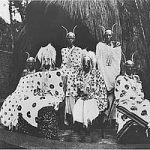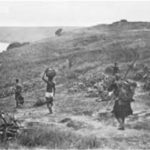Kinyagans And Wage Labor
Work for Europeans within Kinyaga offered only minimal economic advantages; salaries were on the whole low, particularly when compared to benefits to be gained through the sale of livestock and food. With the growth of Bukavu and the expansionof mining activity in Nyungwe forest the demand for these goods rose steadily, resulting in a spiral of rising food prices-a farmer’s paradise.
Kinyagans did not fail to see the advantages in farming, trading, and later (after initial reluctance), growing coffee. The economic good sense of these people was a source of continual fritstration to government agents faced with the demands for workers. In 1942 the Territorial Administrator at Cyangugu commented that:
The extraordinary ease by which the natives of this Territory obtain money no doubt explains why the settlers of the Territory have such difficulty obtaining local workers, and why anything which requires corvée meets with so little enthusiasm.
The same report proposed higher taxes in order to combat this “problem”:
Might it not be advisable to restore the appetite for work in the natives and for the development of the economic resources of the Territory by raising the tax rate substantially?
Use of higher taxes to force Africans into wage labor was a common practice of European colonial governments in Africa. The application of this policy to Kinyaga meant that the taxes for Cyangugu Territory were consistently among the highest in the country. When the Belgian administration first introduced takes in Rwanda in 1917, the tax was 5 francs for each household head in all areas of the country; this was lowered to 3.50 francs in 1922 but restored to 5 francs in 1926. In 1927 the tax was raised to 7.50 francs, and it continued to rise thereafter.
An additional tax was imposed on cattle-owners. In 1920 a man owning more than five head of cattle was taxed 10 francs for the head tax (5 francs more than people withnocattle or less than five cows); in 1921 only those owning more than ten head paid an additional tax, fixed at 7.50 francs, so that a man having ten head of cattle or more would have paid ro francs for the head and cattle tax combined. By 1926 the cattle tax was levied on the basis of 1franc for each head of cattle; this was raised to 2 francs per head in 1927. These taxes continued to increase in subsequent years, supplemented by additional taxes introduced after 1930 (some as money payment for prestations that had formerly been paid in kind, others to finance the running of the chief doms).
During the 1930s different tax levels were introduced for individual territories; by 1940, the taxes demanded of Kinyagans were higher than for any other territory except Kigali. Gisenyi, similar to Cyangugu in its proximity to the Congo and also the object of heavy labor demands, had the same tax levels as Cyangugu. The head tax for Kigali Territory in 1940 was 42 francs, and the “supplementary” tax (levied on men with more than one wife) was 21 francs. The head tax for Cyangugu and Gisenyi Territories in 1940 was 32 francs, while the supplementary tax was 15 francs. However, a special lower tax rate was applied in Cyangugu for workers at the Nyungwe mines; they paid only 25 francs head tax and 12.50 francs supplementary tax.
In 1947, tax rates for most people in Cyangugu Territory were the highest in the country, but for contract workers, taxes were among the lowest. It can be seen that aman living in Cyangugu Territory with no more than one wife and no cattle would have paid a total tax of 80 francs (65 francs head tax for the central government, 10 francs head tax for the chiefdom, 5 francs payment for prestations in kind). In the territories of Kigali, Nyanza, Astrida, and Gisenyi (those having the second highest taxes), a monogamous man with no cattle would have paid 69 francs (55 francs head tax for the government, 9 francs head tax for the chiefdom, 5 francs payment for prestations).
A man with more than one wife paid additional taxes: 50 francs for each wife after the first in Cyangugu; 43 francs in Kigali, Nyanza, Astrida, and Gisenyi Territories. The taxes on cattle and, for prestations were the same for all territories.
Workers in Cyangugu Territory who were employed on contract in a mining, industrial, or agricultural enterprise received a substantial tax break. This policy, proposed some years earlier by the Territorial Administrator at Cyangugu, was authorized at the end of 1946 and applied in Kinyaga from 1947. To qualify for the lower taxes, a man had to have been “in service for at least six months or be in possession of a contract specifying a minimum duration of six months. The language is ambiguous; when the special tax is listed, however, it is usually described as applying to workers under contact. Presumably, then, in 1947 the tax break applied principally, or only, to the 6500 men of Cyangugu Territory who were employed on contract in that year.
If the contract worker was monogamous and had no cattle, he paid 50 francs (34 francs government head tax, 10 francs chiefdom head tax, 4 francs payment for prestations in kind) –or 30 francs less than other taxpayers. For each additional wife, he paid a 30 franc supplementary tax. The tax differential for contract workers in Cyangugu was abolished in 1949, and a new form of tax reduction for contact workers applying to all territories in Rwanda was introduced in 1950. Those who were employed by a non-African for a work contact of at least 300 days and which would be carried out within 15 months from the signing of the contract could claim a 50 percent reduction of the head tax; however, only contract workers who were single or had no more than one wife were eligible.
The presence of European enterprises and thee consequent demand for labor had a dual impact on relations of the population with their chiefs. First, it increased the harshness of demands, contributing to resentment against the patron-chiefs. This was particularly true in Cyesha and lmpara, the chiefdoms bordering Lake Kivu, which had the best land in the region for coffee growing, and where proximity to the lake facilitated transport. Second, for some people, wage labor provided an alternative to clientship and other exactions of the chiefs: it allowed them to acquire a material base outside the control of Tuutsi chiefs. These two factors were closely related, but work for Europeans was not always an “escape,” so both aspects need to be considered.
One source of particular hardship was the recruitment of people to work on a daily basis. A distinction between workers hired by contact, usually for six months to three years, and those hired on a daily basis greatly favored the former; contract workers received better wages (if the rations provided by employers are taken into account), were often lodged by their employer, paid lower taxes, and were supposed to be excused from both ubureetwa obligations (for which they made a money payment) and akazi. Non-contract workers were entitled to none of these privileges.
The situation in Cyesha chiefdom in 1942 provides an illustration of some of the difficulties that recruitment of day workers could cause for the recruits. In the western part of Cyesha, a number of men from the hills bordering the Nyungwe forest worked in the mining installations at Nyungwe and near the Mwaga River; these workers were usually under contract or hired by the month. Normally, such people worked at places close enough to their homes for them to return home at night.
By contrast, day workers often encountered much more difficult conditions. Several European enterprises concentrated in a relatively small area close to the lake created heavy labor demands. Statistics on day workers in Cyesha in 1942 (at the height of the wartime exactions in other spheres) were as follows:
three brick factories 1150
three plantations 16o
two missions 210
Total =1520
The adult male population actually present in Cyesha chiefdom in1942 was estimated at 3050, so that the number of workers employed on a daily basis was nearly 50 percent of the adult male population.
Conditions were especially harsh at two of the brick factories, which each employed 500 men. These factories were located only 90 minutes apart; unable to find enough workers in areas close by, the two establishments resorted to recruitment of men living some distance away. Two subchiefs whose subchiefdoms were located at three to four hours walk in the mountains west of the lake were ordered to produce 200 men each; the predecessors of these subchiefs had recently been deposed for not having produced sufficient numbers of workers. Because of the distance involved, workers had to find lodging near the brick factories during the week. After working full days Monday to Friday, and a half-day on Saturday, they could retun to their homes only for Saturday night and Sunday. The employers apparently provided neither lodging nor rations. Workers coming from the higher altitudes often fellill while living near the lake, and mortality among them was high.
The average wage paid to workers was one franc per day, but at one of the brick factories it was normal practice for the employer to with-hold a part of the workers’ wages as punishment for various infractions; some individuals received only ten francs in 24 days. In addition to poor wages and unhealthy conditions, the workers at that same brick factory frequently suffered physical abuse; they had to be retained at their jobs by force. The morale among workers at the factory was so low that this establishment employing 500 workers produced no more bricks than a third factory in the region (with less harsh working conditions) that employed only 150 workers.
The salary of one franc per day in 1942 appears exceptionally low; in 1929, the Protanag company was paying workers 1.5o francs per day, at a time when the colonial govemment paid ordinary laborers (employed in roadwork and construction) a daily wage of one franc. Moreover, inflation from 1929 to 1942 had reduced the value of the franc; colonial reports often referred to decreased value of money as a justification for yearly tax increases.
The plight of the workers at the brick factories in Cyesha dramatizes the extent of wartime exactions in the region. Although spending the week away from home at their jobs, these workers were stiI1 expected to maintain obligatory–cultivation, coffee plants, and reforestation projects. They were obliged to ask their wives to fulfill these duties or hire mudeyideyi to do it for them. A mudeyideyi was a Rwandan who hired out his services to another Rwandan; he received one franc per day, as well as food and lodging-better conditions than the day workers employed by Europeans. Missionaries at Nyamasheke Mission in Cyesha, appalled at the exactions being made on people in the region, sharply criticized the government policies, but to little avail.
To escape work in the brick factories, many men left the two sub-chiefdoms where local labor recruitment was so high. Some went north to Rusenyi (in present Kibuye Prefecture) where there were fewer European settlers and fewer roads to maintain than in Cyesha. Some went to work in the mines as contract laborers or day workers; others went to hire out as mudeyideyi in other areas of Kinyaga (Impara and Abiiru chiefdoms). This emigration, of course, only made conditions more difficult for those who remained.
In the years after World War II, the Belgian administration introduced measures to stabilize the labor force to reduce the numbers of workers employed by the day while increasing the proportion hired on contract. A report from Cyangugu in 1947 expressed satisfaction at the administration’s success in this regard. As we have seen, by the end of 1947 there were 6500 workers on contract in Cyangugu Territory. Of 2300 workers employed on a daily basis, 1000 had been hired by the government for work on roads.
Although coercion was often used in labor recruitment, some Kinyagans went “voluntarily” to work for Europeans as a means of escaping the demands of the chiefs, or they sought employment on their own (e.g., as contract workers) in order to avoid forcible recruitment on less favorable terms. Given conditions in the subchiefdoms, work in certain European enterprises was viewed by many as the lesser of two evils. For those who wished to escape the chiefs, work to the west in the Congo posed a particularly strong attraction, for it took them outside the region. Some Kinyagans signed on for three-year contracts to work in mines or construction firms in Kivu or Katanga; many sought work as domestic servants or skilled and semi-skilled workers in Bukavu.
Kinyagans interviewed often mentioned arbitrary actions of the powerful as a principal reason they and others went to work for Europeans. In the 1920s, a man from Muramba Hill (Cyesha chiefdom) left for Katanga on a three-year contract to escape his ubuhake patron:
Seeing that I could not flee elsewhere, and that I could not make myself a client of someone else and [stil] continue to live … so it was that I went to the Europeans [to work on European installations] in Katanga to do heavy jobs: to split rocks.
Rurangwa, a Kinyagan who later became an activist in Hutu party politics, said he left his home at Mugera Hill to work at the mines in Katanga (Congo) in 1937; he and several others who accompanied him wished to escape the demands of the chiefs. A man from Shangi (Impara chiefdom), also an activist in Hutu protest of the 1950, recounted that his brother fled and went to work in Bukavu after the chief had taken his land and tried to seize his cattle. Another member of the same lineage was an ubuhake cattle client for a time; finding this unacceptable, he left to work at Kamituga in the Congo.
From the hills near the forest in Kinyaga, considerable numbers of men went to work in the Nyungwe mines to escape akazi and other exactions. As expressed by one informant:
I went there because they were making my wife work and whenever I had same [banana] beer the abamotsa [subordinates of the subchief] would come and take it; but when I got to Nyungwe, no one asked me for anything any more.
From this man’s account, it would seem that the exemptions given to workers on contract (exemptions from ubureetwa and akazi) were enforced. The extent to which occurred, however, varied from one subchiefdom to another and between different individuals as well.
Regardless of the reasons for which Kinyagans went to work for Europeans, participation in wage labor later provided certain of the workers a basis for opposing the system. Whether recruited by direct or indirect coercion, or whether they went “willingly” to escape what they considered an intolerable situation at home, these men were exposed to new experiences and came into contact with ideological alternatives to the Rwandan system. They became aware of different perspectives in social situations where they were not at the mercy of a local chief’s exactions and where they could gain status and economic security outside the sphere of local political power in Kinyaga. In this sense, employment offered to some an alternative to submission to the chiefs. Kinyagans’ participation in the Kivu complex meant that, through jobs or commerce, it became possible to gain an economic base relatively autonomous from the chiefs’ monopoly over the formerly crucial economic resources-cattle and land. Many of the early leaders of Hutu protest activity in Kinyaga were former wage earners who had taken up trading enterprises of some kind-gaining both economic security and a network of contacts that later proved useful for political party organization.
The alternatives open to Kinyagans in the west conditioned the kind of elite that eventually emerged among Hutu of the region, as well as the attitudes of thiselite. The peripheral position of Kinyaga contributed to harsh administrative demands, particularly in Cyesha; at the same time, the fronder position of the region afforded access to ideological alternatives to the Rwandan social system and the possibility of external social security and financial assistance. At the least, the openness to the west provided a chance for certain Kinyagans to remove themselves from the web of local entanglements and hence to achieve some independence of thought and action.
This case study of the Kivu complex shows that the labor control system developed in Kinyaga was particularly intense. But recruitment of workers occurred in other areas of Rwanda as well and Belgian economic policies fostered transformations throughout the country, not just in Kinyaga. As a result, rural dwellers were incorporated into a money economy; some became semi-proletarianized through wage labor, and for many their relationship to the basic means of subsistence was altered. Throughout Rwanda the dual colonial state, ruled by Europeans and by Tuutsi, imposed taxes, compulsory cultivation of certain crops, regulation of the labor force, and forced labor (corvée) which served to make chiefly rule more oppressive and to define the primary objects of this oppression (the Hutu) in ethnic terms. The fact that virtually all the chiefs were Tuutsi helped to create the popular view that “Tuutsi” meant those who were wealthy and powerful and could treat others, especially Hutu, abusively.”Hutu” was synonymous with subordinate, those who were excluded from political power and who were particularly vulnerable to the depredations of the chiefs. One result of these conditions was the development of political consciousness among the rural masses, based on discontent at the treatment meted out by the chiefs. Thus, the dual colonial system, while it attempted to promote the power of chiefs, eroded their legitimacy. Over time, changing relations of production made resources available to some who could use them, in the 1950s, to combat oppressive conditions which were in large part the product of political and economic transformations over the previous half-century.
https://uk.amateka.net/kinyagans-and-wage-labor/https://uk.amateka.net/wp-content/uploads/2020/05/lands.pnghttps://uk.amateka.net/wp-content/uploads/2020/05/lands-150x150.pngModel CitizenshipWork for Europeans within Kinyaga offered only minimal economic advantages; salaries were on the whole low, particularly when compared to benefits to be gained through the sale of livestock and food. With the growth of Bukavu and the expansionof mining activity in Nyungwe forest the demand for these goods...BarataBarata rpierre@ikaze.netAdministratorAMATEKA | HISTORY OF RWANDA




